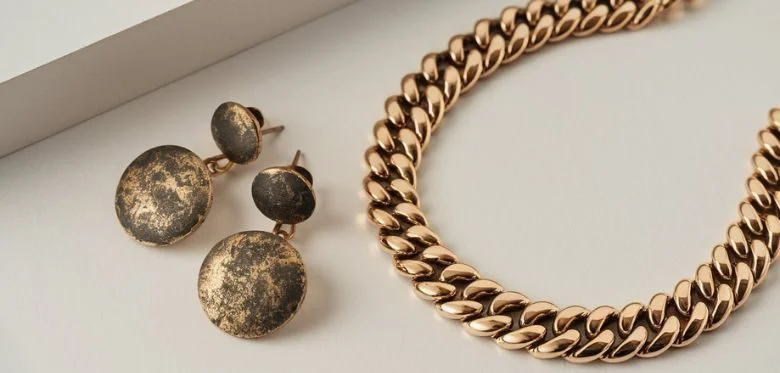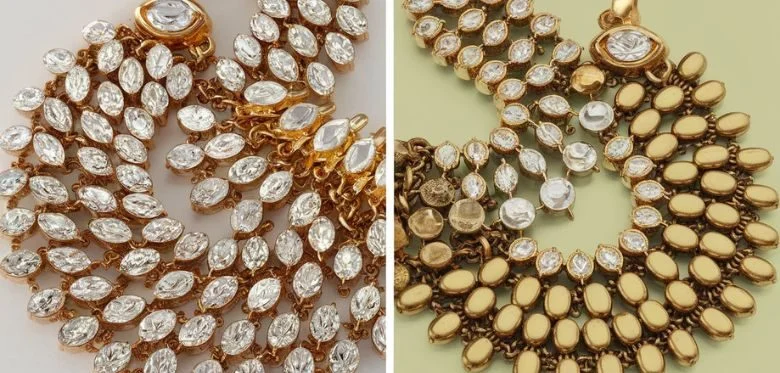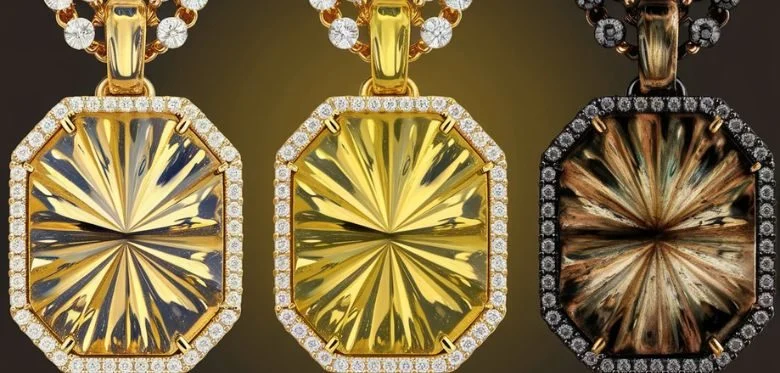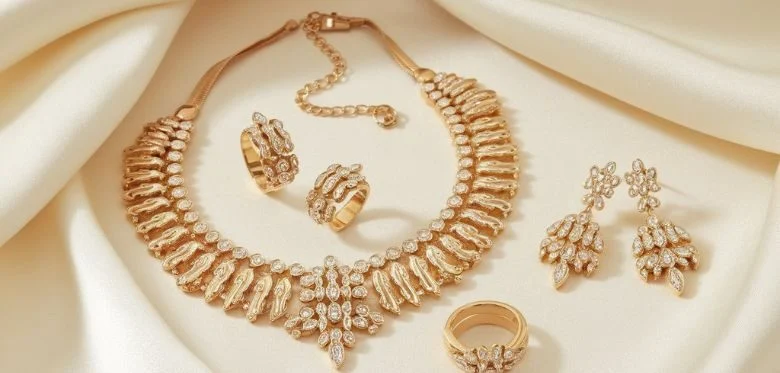Gold-plated jewelry gives you the look of solid gold without the price tag, so it’s no wonder it’s a favorite among fashionistas. But without proper care, this beautiful jewelry can quickly lose its luster and show wear. This comprehensive guide shows you professional techniques to keep your gold-plated pieces for years to come, so you can protect your investment and keep your accessories looking their best. From understanding why tarnishing happens to daily care routines and emergency DIY fixes, you’ll learn everything you need to extend the life of your favorite gold-plated jewelry.
What’s in Gold-Plated Jewelry: What You’re Wearing
Gold-plated jewelry is a base metal (brass, copper or sometimes sterling silver) coated with a thin layer of real gold through an electroplating process. Unlike solid gold pieces, this plating has varying thicknesses measured in microns, which directly affects durability and longevity.

The Science of Gold Plating
The electroplating process creates that beautiful gold exterior by using an electrical current to bond a thin layer of gold to the base metal. Most fashion jewelry has plating between 0.5-2.5 microns thick, higher quality pieces have thicker layers. This thin gold coating is what makes these pieces affordable but also more prone to wear and tarnishing over time.
Why Gold-Plated Jewelry Tarnishes (And How to Stop It)
Gold plating wears down due to exposure to elements like sweat, chemicals and oxygen. Several factors can speed up this process:
pH Levels and Skin Chemistry
Your skin’s natural pH and chemistry can greatly impact how fast gold plating deteriorates. People with more acidic skin (pH below 5) may experience faster tarnishing rates as acids can break down the gold layer. Applying lotion or moisturizer before wearing jewelry helps form a protective layer between your skin and the metal.
Environmental Exposure
Every day, environmental factors pose serious threats to your gold-plated pieces. Chlorine, saltwater, and humidity can speed up tarnishing. Even a single exposure to chlorinated pool water can trigger a corrosion process that cannot be reversed.
7 Professional Tips to Keep Gold-Plated Jewelry Shiny
Learn how to maintain the shine and durability of your gold-plated jewelry with these expert tips.

The Essential Post-Wear Ritual
Create a simple habit after wearing your gold-plated jewelry and you’ll extend its life. Clean your pieces with a soft, lint-free cloth after each wear to remove body oils, dirt and residue. This small habit prevents the accumulation of substances that wear down the gold plating.
For more thorough cleaning, Cult of Sun recommends: “Clean your jewelry once a month with a soft, non-abrasive cloth to remove the buildup of dust and grease from daily wear and maintain shine and gold color”.
Smart Cleaning Practices
When your jewelry needs deeper cleaning, use the right techniques to avoid damaging the gold layer:
DO:
- Soak it in mild soapy water for a few minutes.
- Gently wipe with a soft microfiber cloth
- Air dry completely before storing
DON’T:
- Use ultrasonic cleaners
- Apply abrasive polishing compounds
- Scrub with brushes or rough materials
“If your jewellery needs more cleaning, you may clean it with warm, soapy water. Gently wipe after soaking, but avoid harsh cleaners and antibacterial soaps, they speed up tarnishing.”.
Chemical Avoidance Strategy
The most important part of caring for gold-plated jewellery is to avoid chemical exposure:
- Use perfume, lotion, or makeup before wearing jewelry.
- Wait until products have fully absorbed into your skin
- Remove jewellery before using cleaning products or hair spray
- Keep away from household chemicals
Water Exposure Management
While occasional water exposure won’t destroy your gold plated pieces immediately, repeated exposure will accelerate tarnishing:
“Avoid wearing brass-based jewelry in pools or seawater. Salty or chlorinated water will trigger corrosion, eventually destroying the gold plating”. Additionally, shower products like gels, soaps and shampoos can cause dulling and tarnishing over time. Dive deeper into the details of diamond color and clarity with our comprehensive buyer’s guide, offering expert insights.
Physical Activity Considerations
Remove your gold plated jewellery before engaging in activities that cause friction or sweating:
- Exercise and sports
- Heavy household chores
- Swimming and showering
- Sleeping (to prevent tangling and tugging)
Strategic Storage Solutions
Proper storage makes a big difference on how long your gold plated jewellery will maintain its shine:
“Keep jewelry in its original pouch or box.The pouch/box prevents jewellery from getting rubbed and scratched against other pieces, which is one of the reasons why jewellery gets dull and looses it’s shine”.
Additional storage tips:
- Use anti-tarnish strips or pouches
- Keep pieces separate from each other
- Store in cool, dry places away from bathrooms (humidity accelerates tarnishing)
- Avoid direct sunlight exposure
Rotation System for Daily Wear
If you wear gold plated pieces daily, consider a rotation system. This way pieces can “rest” between wears and not be exposed to skin oils and environmental factors that causes wear.
DIY Fixes for Tarnished Gold-Plated Jewellery
Even with proper care, gold-plated jewellery may still tarnish. Try these gentle DIY solutions for minor issues:
Basic Tarnish Removal
For light tarnishing, make a gentle cleaning solution:
- Mix mild dish soap with warm water
- Soak the jewellery for 5-10 minutes
- Gently wipe with a soft microfiber cloth
- Rinse with clean water and air dry completely
When to Consider Replating vs. Replacing
Understand the important difference between replacing and replacing your gold-plated jewelry to make the right decision.

Signs Your Gold-Plated Jewelry Needs Help
Watch for these signs your jewelry needs professional attention:
- Visible base metal showing through
- Constant discoloration that won’t clean off
- Green marks on skin after wearing
- Excessive scratching or damage to the surface
Conclusion: Get the Most Out of Your Gold-Plated Jewelry
With proper care, gold plated jewelry can last years not months. By following the expert care tips in this guide-from daily wiping to smart storage solutions-you’ll extend the life of your favorite pieces and keep them looking shiny.
Remember prevention is always better than restoration. Establish good habits like removing jewelry before swimming or showering, applying personal care products before jewelry and storing pieces properly will reduce tarnishing and wear.
Whether you invested in high end gold plated pieces or enjoy affordable fashion jewelry, these care practices will get you the most value and enjoyment out of your collection.
FAQs About Gold Plated Jewelry Care
Can I wear gold-plated jewelry every day?
Yes, but daily wear will speed up natural tarnishing. Implement a rotation system, give pieces time to “rest” between wears. Always remove before showering, swimming or exercising and clean gently after each wear.
How long should gold-plated jewelry last?
With proper care, good quality gold-plated jewelry can last 1-3 years with regular wear. Higher micron counts (thicker plating) will last longer. Pieces worn occasionally and cared for properly may last 5+ years.
Does hand sanitizer damage gold-plated jewelry?
Yes. Hand sanitizers contain alcohol and harsh chemicals that can strip gold plating. Remove jewelry before applying sanitizer or wait until it’s dry before putting jewelry back on.
How do I know if my jewelry is gold plated?
Gold plated jewelry may have markings like “GP,” “GEP” (Gold Electroplated) or “Gold Tone.” If unmarked, look for wear spots where the base metal is showing through or ask a jeweler to test.
Is it worth replating gold-plated jewelry?
For good quality pieces with good base metal, replating makes sense. Consider original cost, sentimental value, and quality of construction when deciding to replate or replace.



